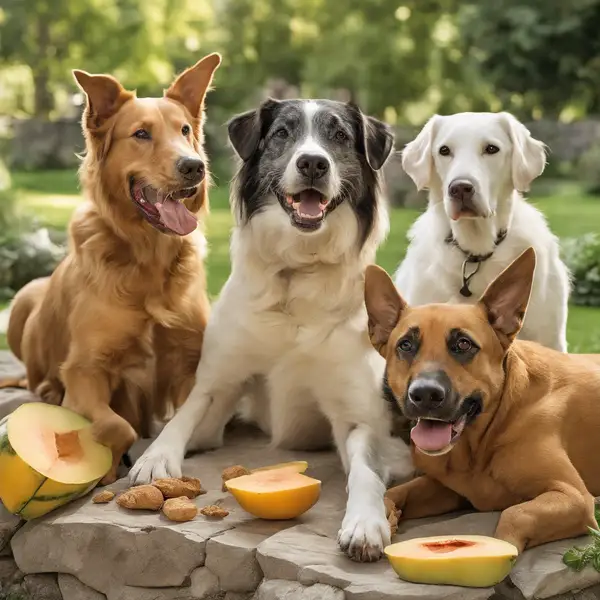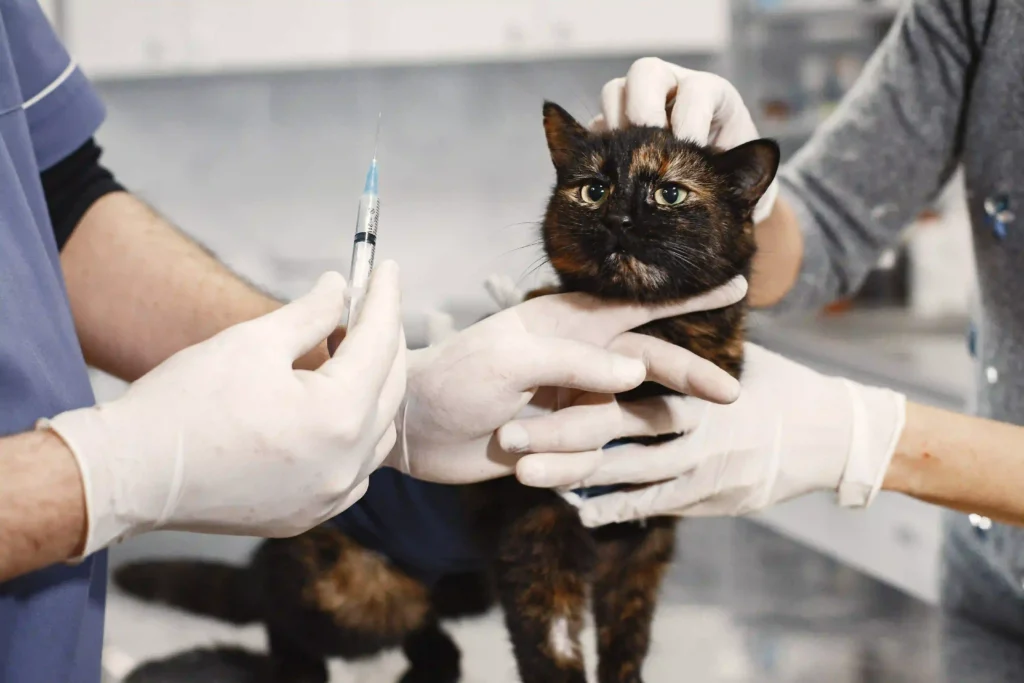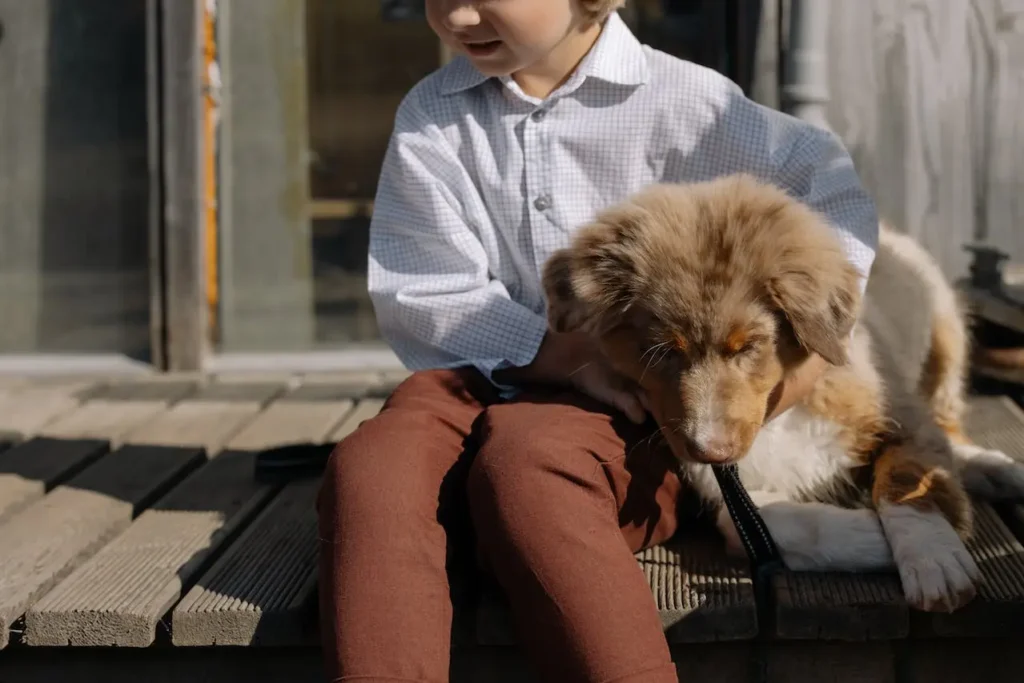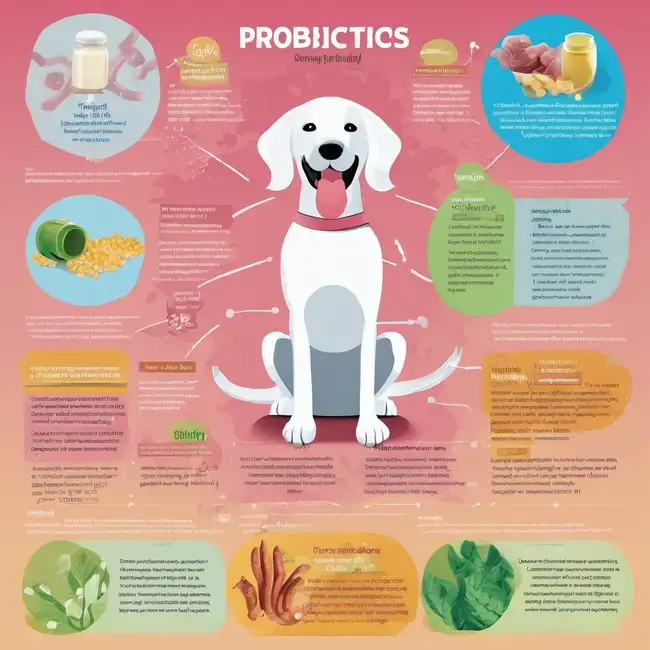Can Dogs Eat Cantaloupe? Find Out The Surprising Truth Now!

- Can Dogs Eat Cantaloupe?
- Health Benefits of Cantaloupe for Dogs
- Safety Precautions When Feeding Cantaloupe For Dogs
- Homemade Cantaloupe Recipes For Your Dog
- Potential Risks Associated With Feeding Cantaloupe For Dogs
- How to Tell if a Cantaloupe is Ripe
- How to Cut a Cantaloupe for Your Dog
- Resources and Expert Opinions
- Conclusion: So, Can Dogs Eat Cantaloupe?
- Frequently Asked Questions (FAQs)
This post may contain affiliate links, meaning I may earn a commission if you make a purchase, at no extra cost to you. I only recommend products I trust. Thank you for your support.
As a dog lover and owner, I’m always on the lookout for healthy and delicious treats to spoil my furry friend.
Recently, I stumbled upon a question that got me thinking, can dogs eat cantaloupe?

After some research, I discovered that not only can dogs enjoy this juicy fruit, but it also comes with a range of health benefits.
In this comprehensive guide, we’ll explore the health advantages and potential risks associated with dogs consuming cantaloupe.
We will also learn the skills of how to cut a cantaloupe and how to tell if a cantaloupe is ripe.
Additionally, we’ll offer cantaloupe recipes for dogs, safety precautions, insights from experts, and ultimately, equip you with the knowledge to confidently answer the question: Can dogs eat cantaloupe?
So, if you’re wondering whether cantaloupe is safe for your canine companion, read on to find out why it’s the paw-some treat you’ve been looking for.
Can Dogs Eat Cantaloupe?
The answer is a resounding yes! Dogs can eat cantaloupe.
Cantaloupe is a safe and healthy treat for dogs when given in moderation. It is a good source of vitamins A and C, and also contains fiber.
However, it’s important to remove the seeds and rind before feeding cantaloupe to your dog, as these parts can be difficult for dogs to digest.
Additionally, too much cantaloupe can cause an upset stomach, so it’s best to introduce it gradually into your dog’s diet and observe for any adverse reactions.
Health Benefits of Cantaloupe for Dogs
Cantaloupe is not just a delicious fruit, it is also packed with essential nutrients that can benefit your furry friend.
Here are some of the health benefits of cantaloupe for dogs
1. Improves hydration
- Cantaloupe is high in water content and made up of 90% water, making it an excellent choice for keeping your dog hydrated, especially during hot summer months.
2. Essential vitamins and minerals
- Cantaloupe is packed with vitamins A, B6, and C, as well as potassium and fiber.
- These nutrients support your dog’s immune system, promote healthy digestion, and contribute to a shiny coat.
3. Contains antioxidants
- Cantaloupe is rich in antioxidants, such as beta-carotene, which helps protect your dog’s cells from damage caused by free radicals.
- Antioxidants play a vital role in reducing the risk of chronic diseases and supporting overall longevity.
4. Improved vision
- The beta-carotene in cantaloupe promotes good eye health in dogs.
- It helps maintain proper vision and prevents conditions such as cataracts and night blindness.
5. Low in calories
- If your dog needs to shed a few pounds or maintain a healthy weight, cantaloupe is an ideal treat.
- With only 34 calories per 100 grams, it’s a guilt-free snack that won’t contribute to weight gain.
6. Electrolyte balance
- Cantaloupe contains essential electrolytes like potassium, which can help maintain proper fluid balance in your dog’s body.
7. Supports immune function
- The vitamins and antioxidants in cantaloupe can help bolster your dog’s immune system, potentially reducing the risk of certain illnesses.
8. Improves bone health
- Cantaloupe contains calcium and phosphorus, essential minerals for maintaining strong and healthy bones in dogs.
9. Improves Digestive Health
- The fiber content in cantaloupe aids in digestion and prevents constipation in dogs.
10. Palatability
- Many dogs find the sweet taste of cantaloupe appealing, making it a tasty and healthy alternative to traditional dog treats.
Remember, moderation is key, and it’s essential to monitor your dog for any adverse reactions when introducing new foods.
Always consult with your veterinarian before making significant changes to your dog’s diet.
Safety Precautions When Feeding Cantaloupe For Dogs
While cantaloupe is generally safe for dogs, there are a few precautions to keep in mind;
1. Remove Seeds and Rind
Before offering cantaloupe to your dog, ensure that all seeds and the rind are removed.
The seeds can pose a choking hazard, and the rind can be difficult for dogs to digest, potentially leading to intestinal blockages.
2. Moderation
Cantaloupe should be given to dogs in moderation. While it offers health benefits, excessive consumption can lead to digestive upset due to its natural sugar content and fiber.
Introduce it gradually into your dog’s diet and monitor their response.
3. Wash Thoroughly
Prior to serving, thoroughly wash the cantaloupe to remove any potential pesticide residues or harmful bacteria on the skin. This can help mitigate the risk of exposing your dog to harmful substances.
4. Monitor for Allergic Reactions
When introducing cantaloupe to your dog’s diet, observe for any signs of allergic reactions, such as itching, swelling, or gastrointestinal distress.
If any adverse reactions occur, discontinue feeding cantaloupe and consult your veterinarian.
5. Avoid additives
When sharing cantaloupe with your dog, make sure it is fresh and free from any additives such as sugar or salt. Stick to plain, natural cantaloupe to keep it healthy and safe for your furry.
6. Consult a Veterinarian
Before making significant changes to your dog’s diet, including the introduction of new foods such as cantaloupe, it’s advisable to consult with a qualified veterinarian.
They can provide personalized recommendations based on your dog’s specific health, dietary needs, and any pre-existing conditions.
By adhering to these safety precautions, you can help ensure that your dog can safely enjoy the potential health benefits of cantaloupe while minimizing the risk of any adverse effects.
Homemade Cantaloupe Recipes For Your Dog
Now that you know the amazing nutritional benefits of cantaloupe for dogs, let’s dive into some delicious homemade cantaloupe recipes that will have your furry friend begging for more!
These cantaloupe recipes are simple to make and are sure to delight your pup’s taste buds.
1. Frozen Cantaloupe Bites:
- Ingredients:
- 1 ripe cantaloupe, peeled and seeds removed
- 1 cup plain Greek yogurt
- 2 tablespoons honey (optional)
- Instructions:
- Cut the cantaloupe into small cubes.
- Blend the cantaloupe cubes, Greek yogurt, and honey (if using) until smooth.
- Pour the mixture into an ice cube tray or silicone mold.
- Freeze for at least 2 hours or until firm.
- Pop out the frozen cantaloupe bites and serve to your dog as a refreshing treat.
2. Cantaloupe and Chicken Jerky Wraps:
- Ingredients:
- 1 ripe cantaloupe, sliced into thin strips
- 1 cup cooked chicken breast, shredded
- Instructions:
- Preheat your oven to 200°F (95°C).
- Lay the cantaloupe strips on a baking sheet lined with parchment paper.
- Place a small amount of shredded chicken at one end of each cantaloupe strip.
- Roll up the cantaloupe strip tightly, securing it with a toothpick if needed.
- Bake in the oven for 2-3 hours or until the cantaloupe is slightly dehydrated and the chicken is crispy.
- Allow the wraps to cool before serving them to your dog.
3. Cantaloupe and Peanut Butter Pupsicles:
- Ingredients:
- 1 ripe cantaloupe, peeled and seeds removed
- 1/2 cup natural peanut butter
- 1/4 cup coconut milk (optional)
- Instructions:
- Blend the cantaloupe until smooth.
- In a separate bowl, mix the peanut butter and coconut milk until well combined.
- Pour a layer of the cantaloupe puree into popsicle molds or ice cube trays.
- Add a dollop of the peanut butter mixture on top of the cantaloupe layer.
- Repeat the layers until the molds are filled.
- Insert popsicle sticks into the molds and freeze for at least 4 hours or until solid.
- Remove the pupsicles from the molds and let your dog enjoy this sweet and savory treat.
4. Cantaloupe and Oatmeal Biscuits:
- Ingredients:
- 1 ripe cantaloupe, mashed
- 2 cups rolled oats
- 1/4 cup unsweetened applesauce
- Instructions:
- Preheat your oven to 350°F (175°C) and line a baking sheet with parchment paper.
- In a large bowl, combine the mashed cantaloupe, rolled oats, and applesauce.
- Mix well until the ingredients form a sticky dough.
- Drop spoonfuls of the dough onto the prepared baking sheet, spacing them apart.
- Flatten each dough ball with the back of a spoon.
- Bake for 15-20 minutes or until the biscuits are golden brown and firm.
- Allow them to cool completely before serving them to your furry friend.
5. Cantaloupe and Cottage Cheese Smoothie:
- Ingredients:
- 1 ripe cantaloupe, peeled and seeds removed
- 1/2 cup cottage cheese
- 1/4 cup water
- Instructions:
- Blend the cantaloupe, cottage cheese, and water until smooth.
- Pour the smoothie into a bowl or freeze it in an ice cube tray for a frosty treat.
- Serve the smoothie as is or freeze it for a few hours for a more refreshing experience.
- Your dog will love the combination of creamy cottage cheese and sweet cantaloupe.
These homemade cantaloupe dog recipes are not only easy to make but also provide a healthy alternative to store-bought treats.
Potential Risks Associated With Feeding Cantaloupe For Dogs
While cantaloupe can offer numerous health benefits for dogs, there are potential risks to be aware of:
1. Digestive upset
Feeding too much cantaloupe to your dog can lead to digestive upset, including diarrhea and stomach discomfort. Introduce cantaloupe gradually into your dog’s diet to assess their tolerance.
2. Obstruction
The seeds and rind of cantaloupe can pose a choking hazard or, in some cases, lead to intestinal obstruction. Always ensure that the seeds and rind are removed before feeding cantaloupe to your dog.
3. Sugar content
Cantaloupe contains natural sugars which, if consumed in large quantities, can affect blood sugar levels, especially in dogs with diabetes or those prone to weight gain.
4. Allergies
Some dogs may be allergic to cantaloupe, which can manifest as itching, gastrointestinal upset, or other allergic reactions. Watch for any signs of allergic response when introducing cantaloupe to your dog.
5. Pesticides
If not properly washed, the skin of the cantaloupe may contain pesticide residues, which could be harmful to your dog. Always wash the fruit thoroughly and consider purchasing organic cantaloupe when possible.
6. Bacterial contamination
Like any fruit, cantaloupe can carry harmful bacteria on its skin, so it’s important to wash it thoroughly before feeding it to your dog.
Always consult with your veterinarian before adding cantaloupe or any new food to your dog’s diet, especially if your dog has underlying health conditions or dietary restrictions.
Additionally, ensure that cantaloupe is offered as an occasional treat and not as a primary component of your dog’s diet.
How to Tell if a Cantaloupe is Ripe
Wondering how to tell if a cantaloupe is ripe? Worry not.

To ensure your dog enjoys the best quality fruit, follow these simple tips when selecting a cantaloupe:
1. Check the color
- A ripe cantaloupe will have a vibrant orange skin with a slightly golden hue.
- Avoid melons that are green or have a pale color, as they may not be fully ripe.
2. Feel the texture
- Gently press the ends of the cantaloupe with your fingers.
- If it gives slightly and feels firm yet slightly soft, it’s likely ripe.
- However, if it is too mushy or too hard, it may be overripe or underripe, respectively.
3. Smell the cantaloupe
- Take a whiff of the stem end of the cantaloupe.
- A ripe fruit will have a sweet and fragrant aroma.
- If it smells sour or has no smell at all, it may not be ripe.
By following these guidelines, you can ensure that your furry friend gets the tastiest and most nutritious cantaloupe possible.
How to Cut a Cantaloupe for Your Dog
Follow these steps on how to cut a cantaloupe to safely prepare this paw-some treat:

1. Wash the cantaloupe
- Rinse the cantaloupe thoroughly under cool running water to remove any dirt or bacteria from the skin.
2. Cut off the ends
- Using a sharp knife, slice off both ends of the cantaloupe.
3. Slice in half
- Stand the cantaloupe upright on one of its cut ends and carefully slice it in half from top to bottom.
- Carefully slice away the outer rind, following the curve of the fruit
4. Remove the seeds
- Use a spoon to scoop out the seeds and discard them. Cantaloupe seeds can be a choking hazard for dogs.
5. Slice or dice
- Depending on your dog’s preference, you can either slice the cantaloupe into wedges or dice it into bite-sized pieces.
Remember to remove the rind before serving the cantaloupe to your furry friend.
Dogs may struggle to chew or digest the tough skin, so it’s best to remove it to prevent any potential choking or digestive issues.
Resources and Expert Opinions
When considering cantaloupe for dogs, it’s crucial to seek expert opinions to ensure the safety and well-being of your canine companion.
Here are some expert opinions and insights about cantaloupe for dogs:
1. American Kennel Club (AKC) Expert Opinion
The AKC emphasizes that cantaloupe for dogs can be a safe snack for dogs when served in moderation.
However, for dogs with specific health concerns like diabetes, it’s crucial to find the right food based on their health and size.
Consultation with licensed veterinarians is recommended to discuss your dog’s nutrition and dietary needs.
2. PetMD
The source provides guidelines for cantaloupe for dogs, emphasizing the benefits of the fruit and the precautions to take.
It also advises monitoring for adverse reactions after introducing new foods to a dog’s diet.
3. Canine Journal
Canine Journal discusses the nutritional benefits of cantaloupe for dogs, highlighting its essential nutrients and the importance of feeding it in moderation.
It advises pet owners to introduce cantaloupe gradually and observe for any signs of intolerance or allergies.
These expert opinions answer the question, “Can dogs eat cantaloupe?” by stressing proper preparation, and monitoring for potential risks or adverse reactions when feeding cantaloupe to dogs.
Conclusion: So, Can Dogs Eat Cantaloupe?
In conclusion, If you’re still wondering “Can dogs eat cantaloupe?”, the answer is yes.
Not only is it a delicious and refreshing treat, but it also offers a range of health benefits.
From supporting their immune system to aiding digestion and hydration, cantaloupes are a nutritious choice for your furry friend.
Remember to introduce cantaloupe gradually and in moderation, always remove the seeds, and avoid any additives.
Knowing how to cut a cantaloupe and how to tell if a cantaloupe is ripe are essential steps when incorporating this fruit into your dog’s diet.
Following these procedures ensures that you serve the best slices for your canine companion.
For those feeling adventurous and looking for cantaloupe recipes, consider exploring options to create homemade dog treats, providing an extra special culinary experience for your furry pet.
They’ll thank you with wagging tails and slobbery kisses!
- How to comfort a dog with pancreatitis.
- 30-day low FODMAP meal plan
- 21-day fatty Liver diet plan
- Best Probiotics for dogs recommended by experts.
- What are the best probiotics for women recommended by experts?
- Find the best vet in your area, hip dysplasia in dogs
- 20 cost-saving finger food ideas.
- 100 snack ideas for a low FODMAP diet.
- What is the life expectancy with fatty liver?
Frequently Asked Questions (FAQs)
Can dogs eat the rind of a cantaloupe?
No, dogs should not eat the rind of a cantaloupe. The rind can be tough to chew and may cause digestive issues or pose a choking hazard. Always remove the rind before serving cantaloupe to your furry friend.
Can dogs eat cantaloupe melon?
Yes, dogs can safely eat cantaloupe in moderation. It provides a tasty and hydrating treat. Remove seeds and rind, and ensure it’s served in bite-sized pieces to prevent choking. Always consult your vet if introducing new foods to your dog’s diet.
Can puppies eat cantaloupe?
Yes, puppies can eat cantaloupe, but it should be introduced gradually and in moderation. Ensure that the cantaloupe is ripe, remove the seeds, and cut it into small, bite-sized pieces for easier consumption.
Can cantaloupe cause an upset stomach in dogs?
While cantaloupe is generally safe for dogs, some may experience an upset stomach or diarrhea if they consume too much. Introduce cantaloupe gradually and monitor your dog for any adverse reactions.
How to tell if a cantaloupe is ripe?
To determine if a cantaloupe is ripe, consider these factors:
- Color: A ripe cantaloupe displays a golden or creamy hue beneath the net-like rind.
- Texture: Gently press the blossom end; it should yield slightly without feeling overly soft.
- Aroma: Ripe cantaloupes emit a sweet, fruity fragrance at the stem end.
- Netting: The net-like pattern on the rind should be well-defined, and the skin slightly rough.
- Weight: A ripe cantaloupe feels heavy for its size, indicating juiciness.
Treat your furry friend to a delicious cantaloupe snack today and witness the joy firsthand!




